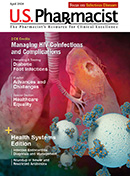Philadelphia—Concerned about the dangers of hypoglycemia to diabetes patients, as well as its high financial costs, the Endocrine Society is in the process of developing an initiative to improve prevention and surveillance of the condition.
A small study published in the Journal of Clinical Endocrinology & Metabolism suggests an important tool that can be used to meet those goals: continuous glucose monitors (CGM) for long-term type 1 diabetes patients.
Patients with severe hypoglycemia can lose consciousness, have seizures, or even die. In fact, the Endocrine Society points out that hypoglycemia related to insulin use was linked to an estimated $600 million in emergency department visits between 2007 and 2011.
“In individuals who have repeatedly experienced hypoglycemia, the body blunts awareness of symptoms warning of impending episodes,” explained lead author Michael R. Rickels, MD, MS, of the Perelman School of Medicine at the University of Pennsylvania. “Wearing a continuous glucose monitor that flags falling glucose levels and has built-in alarms raises recognition of the threat.”
The study focused on 11 type 1 diabetes patients who had been diagnosed for at least 10 years. They were monitored before, and then 6 and 18 months after, initiation of CGM, and were compared with 12 nondiabetic control subjects.
Results indicate that the participants improved in their awareness of hypoglycemia, as shown through Clarke score, and in the severity of the condition, without change in HbA1c, which was an average of 7.2 at baseline.
“In response to insulin-induced hypoglycemia, endogenous glucose production did not change from before to 6 months (0.42 ± 0.08 vs. 0.54 ± 0.07 mg·kg-1·min-1), but improved after 18 months (0.84 ± 0.15 mg·kg-1·min-1; P <.05 vs. before CGM), albeit remaining less than in controls (1.39 ± 0.11 mg·kg-1·min-1; P ≤.01 vs. all),” the study authors report.
“While the body's own defenses against hypoglycemia did not improve, CGMs filled a valuable need in alerting individuals to oncoming episodes,” Rickels added. “In the absence of physiologic defenses against the development of low blood glucose, near-constant use of continuous glucose monitoring may be required to minimize the burden of problematic hypoglycemia in patients with long-standing type 1 diabetes.”
« Click here to return to Weekly News Update.A small study published in the Journal of Clinical Endocrinology & Metabolism suggests an important tool that can be used to meet those goals: continuous glucose monitors (CGM) for long-term type 1 diabetes patients.
Patients with severe hypoglycemia can lose consciousness, have seizures, or even die. In fact, the Endocrine Society points out that hypoglycemia related to insulin use was linked to an estimated $600 million in emergency department visits between 2007 and 2011.
“In individuals who have repeatedly experienced hypoglycemia, the body blunts awareness of symptoms warning of impending episodes,” explained lead author Michael R. Rickels, MD, MS, of the Perelman School of Medicine at the University of Pennsylvania. “Wearing a continuous glucose monitor that flags falling glucose levels and has built-in alarms raises recognition of the threat.”
The study focused on 11 type 1 diabetes patients who had been diagnosed for at least 10 years. They were monitored before, and then 6 and 18 months after, initiation of CGM, and were compared with 12 nondiabetic control subjects.
Results indicate that the participants improved in their awareness of hypoglycemia, as shown through Clarke score, and in the severity of the condition, without change in HbA1c, which was an average of 7.2 at baseline.
“In response to insulin-induced hypoglycemia, endogenous glucose production did not change from before to 6 months (0.42 ± 0.08 vs. 0.54 ± 0.07 mg·kg-1·min-1), but improved after 18 months (0.84 ± 0.15 mg·kg-1·min-1; P <.05 vs. before CGM), albeit remaining less than in controls (1.39 ± 0.11 mg·kg-1·min-1; P ≤.01 vs. all),” the study authors report.
“While the body's own defenses against hypoglycemia did not improve, CGMs filled a valuable need in alerting individuals to oncoming episodes,” Rickels added. “In the absence of physiologic defenses against the development of low blood glucose, near-constant use of continuous glucose monitoring may be required to minimize the burden of problematic hypoglycemia in patients with long-standing type 1 diabetes.”





